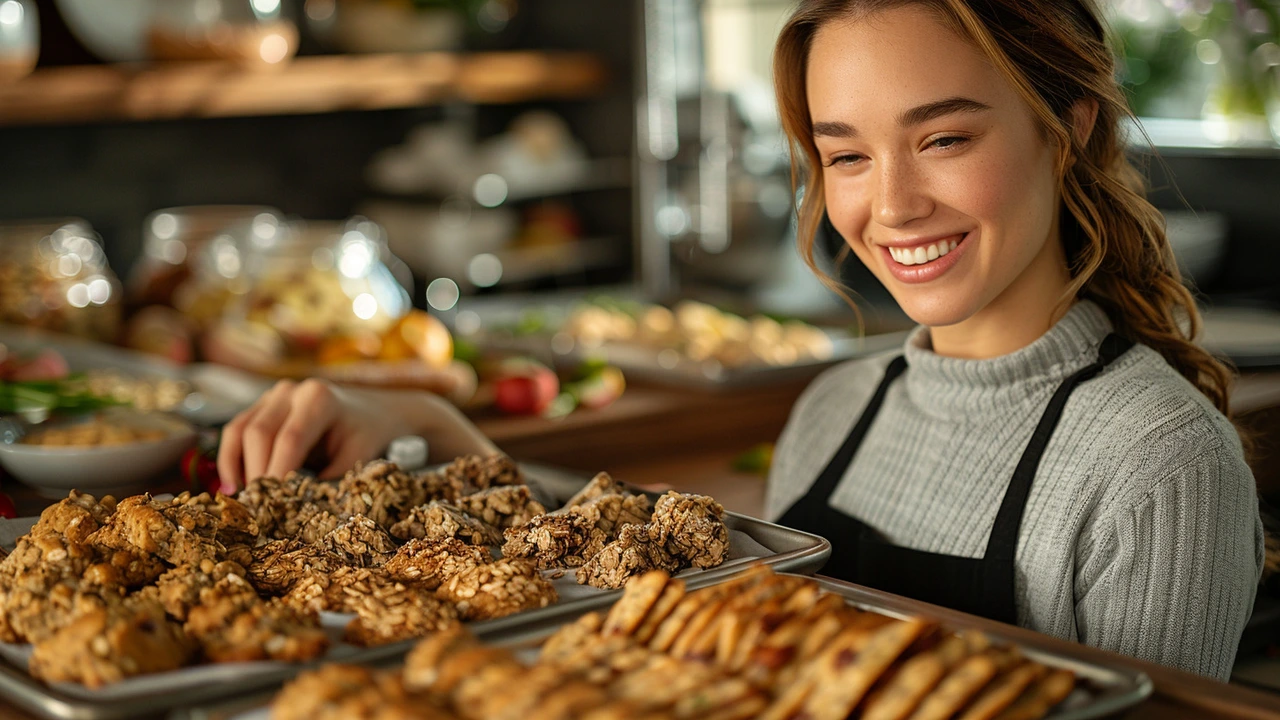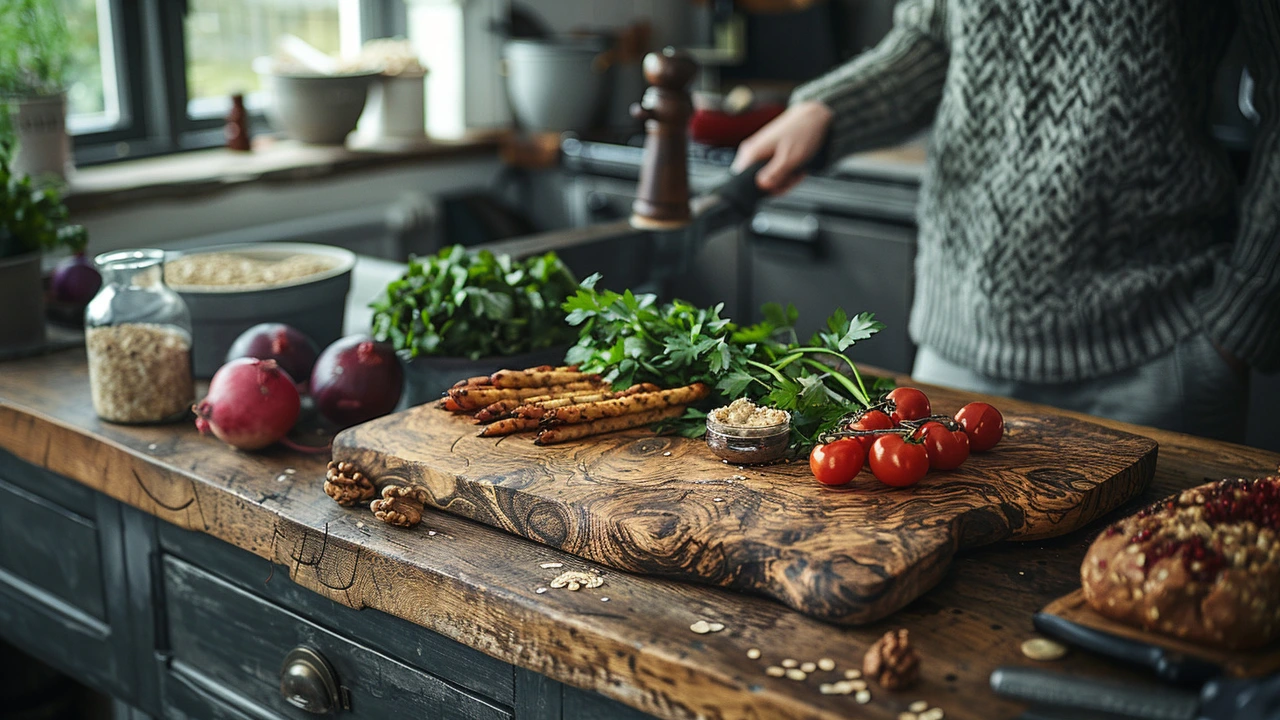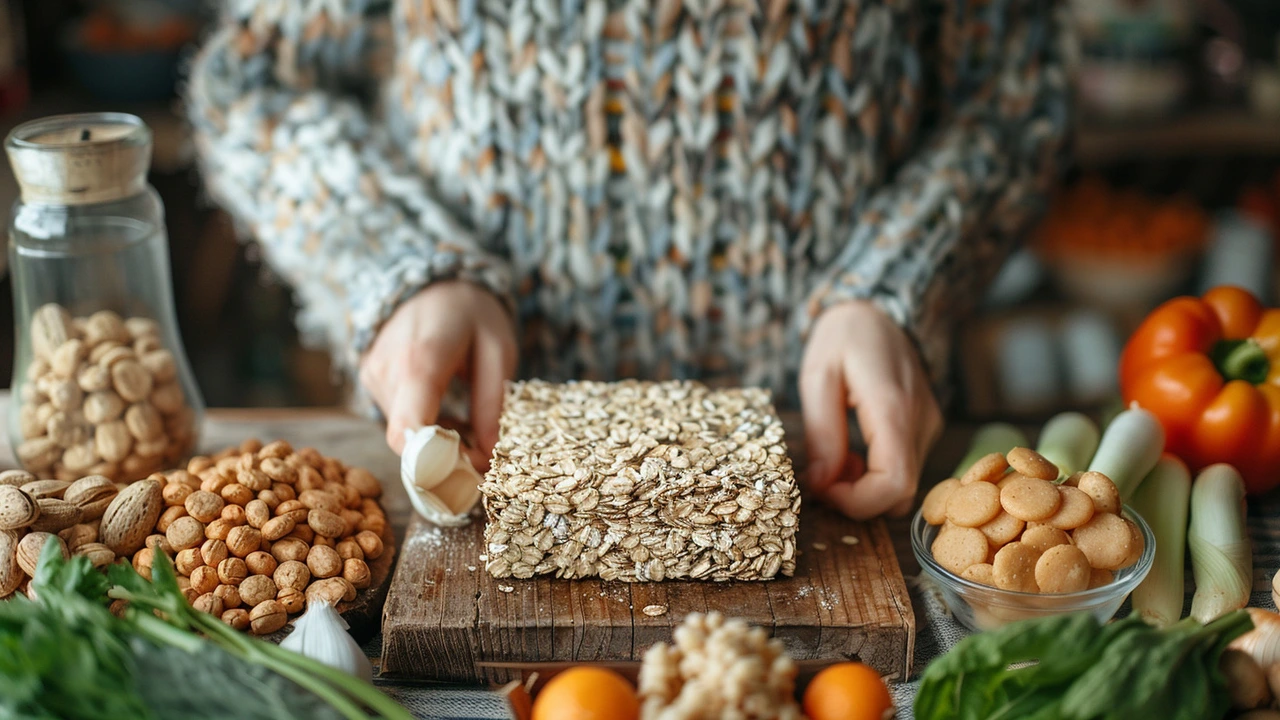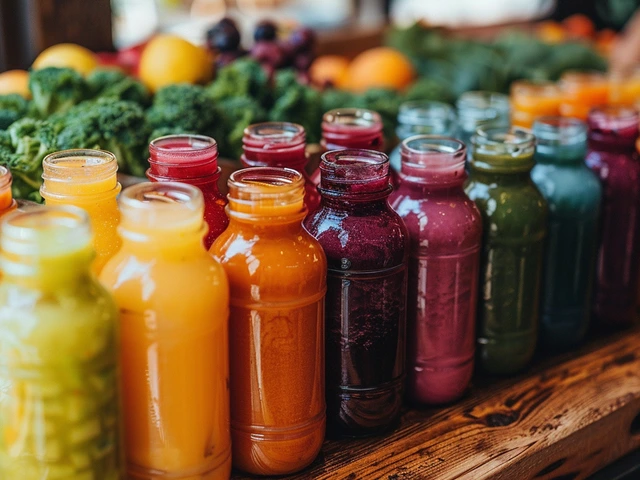
Talk about having snacks that don't just taste amazing but are also good for you! If you're on a gluten-free diet, the good news is there are loads of healthy snacks you can enjoy. Gluten-free snacks can be a game-changer, making sure you stay energized whether you’re at home, work, or school.
Gluten is a protein found in wheat, barley, and rye. For people with celiac disease or gluten sensitivity, consuming gluten can lead to serious health problems. But even if you don’t have these conditions, choosing gluten-free snacks can sometimes be a healthier option.
In this guide, we'll dive into what a gluten-free diet is and why you might want to try it. We’ll also share the benefits of snacking gluten-free and list some essential ingredients to keep on hand. You'll discover quick and easy recipes, shopping tips, and even fun snack ideas for the kids.
Stick around, and let’s make gluten-free snacking easy and exciting!
- Understanding Gluten-Free Diets
- Benefits of Gluten-Free Snacks
- Essential Gluten-Free Ingredients
- Easy Gluten-Free Snack Recipes
- Tips for Shopping Gluten-Free
- Creative Snack Ideas for Kids
Understanding Gluten-Free Diets
Let's start with the basics: what exactly is a gluten-free diet? A gluten-free diet means you avoid any foods that contain gluten. Gluten is a protein found particularly in wheat, barley, and rye. It's what gives bread its chewy texture and helps it rise. But for some people, gluten can be a troublemaker.
Those with celiac disease, an autoimmune disorder, can't consume gluten at all. Even small amounts can cause damage to their intestines, leading to malnutrition and a host of other health problems. But it's not just celiac sufferers who benefit from cutting out gluten. Many people have gluten sensitivity or intolerance, which leads to bloating, headaches, and fatigue.
Studies estimate that about 1% of the population has celiac disease, while another 6% may have some form of gluten sensitivity. That's a significant number of people who need or choose to avoid gluten. And if you're one of them, you're in luck. The availability and variety of gluten-free products have grown exponentially in recent years.
"The rise in gluten-free foods has made life easier and much more delicious for those who need to avoid gluten," says Alice Bast, president and CEO of Beyond Celiac.
So, what do you eat if you're off gluten? The good news is many natural foods are gluten-free. Fruits, vegetables, meat, poultry, fish, beans, legumes, and most dairy products are all safe bets. It’s the processed foods you'll need to watch out for. Gluten often sneaks into sauces, salad dressings, and even some candies. Reading labels becomes crucial. Look for products labeled 'gluten-free,' which means the food contains less than 20 parts per million of gluten, a threshold deemed safe by the FDA.
When transitioning to a gluten-free diet, the initial phase can be challenging. You may need to say goodbye to your favorite bread or pasta brands. However, many gluten-free alternatives are available. Gluten-free breads, pasta, and snacks have evolved in quality and taste, making the switch less daunting.
Studies show that a gluten-free diet can lead to improved digestion, increased energy levels, and better overall health, even if you don't have celiac disease. Some people find that eliminating gluten helps them lose weight and feel better mentally. But it's important to get a proper diagnosis if you suspect gluten is an issue for you. Self-diagnosing and removing gluten unnecessarily can lead to nutritional deficiencies.
There are also social and psychological aspects to consider. Dining out and attending social events can be tricky on a gluten-free diet. However, being prepared can make things easier. Carrying gluten-free snacks and researching food options ahead of gatherings can help mitigate these challenges. Your dietary needs shouldn't limit your social life.
Benefits of Gluten-Free Snacks
Switching to gluten-free snacks isn't just about avoiding gluten; it's about making choices that can have a positive impact on your health and well-being. For those who have been diagnosed with celiac disease or non-celiac gluten sensitivity, removing gluten from their diet is a necessity. Gluten consumption for them can lead to a range of issues, from digestive discomfort to more severe health complications.
One of the clear benefits of gluten-free snacks is that they can aid in better digestion, particularly for those with gluten intolerance. By eliminating gluten, many people report a significant reduction in symptoms like bloating, gas, and abdominal pain. A healthier gut can lead to better nutrient absorption, which is essential for overall health.
Choosing gluten-free options can also help reduce inflammation. Some studies suggest that consuming gluten can spur inflammation in some individuals, even those who aren't celiac. By opting for gluten-free snacks, you may lower your risk of chronic inflammation, which is linked to conditions such as heart disease and arthritis. Research is still ongoing, but the potential anti-inflammatory benefits are promising.
Going gluten-free often encourages people to be more mindful of what they're eating. They tend to read food labels more carefully and might be more likely to include whole, unprocessed foods in their diet. These foods – such as fruits, vegetables, nuts, and seeds – are naturally gluten-free and packed with essential nutrients, vitamins, and minerals.
“A gluten-free diet can be a healthier way to eat if you’re paying attention to the choices you’re making. Fresh fruits and vegetables are gluten-free and good for you.” — Mayo Clinic
Another interesting benefit is the potential for weight management. Many processed foods containing gluten come with empty calories, added sugars, and unhealthy fats. By choosing gluten-free snacks, which often prioritize healthier ingredients, you may find it easier to maintain or even lose weight.
For parents, like myself, providing gluten-free snacks for kids can mean fewer worries about sudden allergic reactions or digestive upset. It’s a way to ensure they’re fueling their bodies with wholesome, nutrient-dense foods. In fact, you'll often find that gluten-free snacks can double as energy boosters. Many options are rich in fibers, proteins, and healthy fats, offering sustained energy levels which are perfect for children’s busy schedules and active playtimes.
Moreover, embracing gluten-free snacks can open up new culinary horizons. Exploring recipes and products leads to discovering delicious alternatives that you might not have considered otherwise. For instance, snacks made from quinoa, chickpeas, or almond flour can become new family favorites. Gluten-free eating doesn't mean sacrificing taste; in fact, it can introduce a variety of rich and exciting flavors to your diet.
Overall, the benefits of adopting gluten-free snacks are multi-fold. From improved digestion and reduced inflammation to better weight management and vibrant new flavors, there’s a lot to gain. As more people become aware of these advantages, the demand for tasty and healthy gluten-free options continues to grow, ensuring better choices for everyone.

Essential Gluten-Free Ingredients
When it comes to maintaining a gluten-free diet, knowing what ingredients to stock your pantry with is key. This knowledge not only ensures that your snacks are safe to eat but also keeps them tasty and nutritious. Here are some essential gluten-free ingredients that you should have at your disposal.
Rice and Rice Flour: Rice is a versatile staple of the gluten-free diet. Both white and brown rice can be used in various dishes, and rice flour is a great substitute for wheat flour in baking. You can make anything from bread to cakes with rice flour.
Quinoa: Quinoa has become incredibly popular as a superfood. Not only is it gluten-free, but it also provides a good source of protein and fiber. Quinoa can be easily incorporated into salads, soups, or even as a base for a hearty snack bowl.
Oats: Make sure to buy oats labeled 'gluten-free' because regular oats might be contaminated with gluten through processing. Gluten-free oats can be used to make delicious oatmeal, granola bars, or sprinkled on yogurt for a quick snack.
Nuts and Seeds: Almonds, peanuts, chia seeds, and flaxseeds pack a nutritional punch and are perfect for snacking. They're high in protein and healthy fats, making them a satisfying option. You can eat them raw, roasted, or even blend them into nut butters and seed spreads.
Fruits and Vegetables: Fresh, frozen, or dried, fruits and vegetables are naturally gluten-free and rich in vitamins, minerals, and fiber. Apples, berries, carrots, and peppers make excellent, convenient snacks.
Legumes: Beans, lentils, and chickpeas are not only gluten-free but are also packed with protein and fiber. Roasted chickpeas, for example, are a crunchy and delightful snack.
Corn and Cornmeal: Corn can be turned into a variety of gluten-free snacks, including popcorn, corn tortillas, and polenta. Cornmeal is also a fantastic gluten-free alternative for baking and frying.
Celiac Disease Foundation highlights, “Naturally gluten-free grains such as rice, corn, and oats help those with gluten sensitivity enjoy a varied and balanced diet while avoiding gluten-related health issues.”
Gluten-Free Flours: Besides rice flour, there are a plethora of other gluten-free flours available. Almond flour, coconut flour, and tapioca flour are some of the most popular options. These flours can be used in different combinations to achieve the desired texture and taste in your foods.
Dairy Products: Most dairy products are naturally gluten-free, but it’s always wise to read labels for potential additives. Greek yogurt, for instance, can be an excellent base for a gluten-free snack parfait. Add some fruits, nuts, and gluten-free granola and you’re set.
Making sure your snacks are gluten-free doesn’t mean you have to compromise on variety or taste. With these essential ingredients, you can create a range of delicious and healthy snack options. By being mindful of what you stock in your pantry, you can easily whip up snacks that are safe and enjoyable for everyone.
Easy Gluten-Free Snack Recipes
Finding tasty and easy gluten-free snack recipes can really help stay motivated on a gluten-free diet. Whether you're dealing with celiac disease, gluten sensitivity, or just exploring healthier diet options, having a variety of snacks to choose from keeps things interesting and satisfying. Below are some simple yet delicious gluten-free snacks that require minimal time and effort to prepare.
First up, let’s talk about **gluten-free granola bars**. These are ideal for those busy mornings or when you’re on the go. Made with gluten-free oats, nuts, seeds, and a touch of honey, these bars are both nutritious and tasty. You can add dried fruits like cherries or apricots to enhance the flavor and add some extra vitamins and fiber. To make, simply mix all ingredients, spread them in a pan, and bake until golden brown. Store them in an airtight container, and you have a handy snack for the week.
According to a study published in the *American Journal of Clinical Nutrition*, incorporating nuts into your diet can help maintain heart health due to their high content of unsaturated fats and essential nutrients.
Next, let's consider **fresh fruit with nut butter**. Apples and bananas paired with almond or peanut butter make an excellent quick snack. Not only are they rich in essential vitamins and minerals, but they also provide a good dose of protein and healthy fats. Just slice the fruit and dip or spread the nut butter on top. It's simple, quick, and fulfills that sweet craving in a nutritious way.
An often overlooked but delightful option is **cheese and rice cakes**. Rice cakes are naturally gluten-free and come in various flavors to suit your taste. A slice of cheese on a rice cake offers a good balance of carbs and protein, perfect for a mid-day bite. To make it more interesting, you can add a slice of tomato or avocado on top.
If you have a bit more time, try making **homemade popcorn**. Popcorn is naturally gluten-free and can be a healthy snack if prepared correctly. Use an air-popper or cook the kernels in a bit of coconut or olive oil. Season with sea salt, nutritional yeast for a cheesy flavor, or even a sprinkle of cinnamon for a sweet twist. It's a light yet satisfying snack that the whole family can enjoy.
For something savory, consider **vegetable sticks with hummus**. Slices of carrots, celery, and bell peppers pair wonderfully with hummus, which is naturally gluten-free and packed with protein and fiber. It's colorful, crunchy, and satisfying. Make your own hummus at home by blending chickpeas, tahini, garlic, lemon juice, and a splash of olive oil for a fresher taste and more control over the ingredients.
Lastly, **yogurt with gluten-free granola** or seeds can be a delightful snack. Many brands now offer gluten-free yogurt options that are full of probiotics, which promote good gut health. Top your yogurt with gluten-free granola, chia seeds, or flaxseeds to add a crunch and enhance its nutritional profile. This snack is not only tasty but also very healthy.
Preparing gluten-free snacks doesn't have to be complicated or time-consuming. With a little creativity and the right ingredients, you can enjoy a variety of delicious and nutritious snacks that cater to your dietary needs. Happy snacking!

Tips for Shopping Gluten-Free
Shopping for gluten-free foods can seem like a daunting task, but it becomes much easier with a few helpful strategies. First and foremost, it’s crucial to understand labels. Always look for products labeled as 'Certified Gluten-Free'. This certification ensures the product has been tested and contains less than 20 parts per million (ppm) of gluten, a safe threshold for individuals with celiac disease. Frequently, you may also see symbols like the crossed grain symbol, which is a reliable indicator.
Pay attention to ingredient lists. Gluten can hide in unexpected places under names like 'modified food starch', 'malt', or 'hydrolyzed vegetable protein'. Luckily, there are handy mobile apps that can scan barcodes and let you know if an item is safe to eat. When in doubt, contact the manufacturer directly. Be cautious of cross-contamination as well, particularly with items like oats, which are often processed in the same facilities as wheat. Look for oats specifically labeled as 'gluten-free'.
As researcher Dr. Alessio Fasano notes, 'Gluten-free should never mean nutrition-free. Quality in gluten-free foods is essential for a balanced diet.'
Plan your shopping trip strategically. Start by shopping the perimeter of the store. This area usually contains naturally gluten-free whole foods such as fruits, vegetables, meats, and dairy products. The interior aisles, while sometimes overwhelming, can be navigated wisely by sticking to brands known for their gluten-free options. Some popular brands offering a variety of gluten-free products include Bob’s Red Mill, Glutino, and Udi’s.
Make a list before heading to the grocery store. Having a predefined list helps you stay focused and avoid potential pitfalls. It's also helpful to shop at stores known for their gluten-free selections. Natural food stores and larger supermarkets often have dedicated gluten-free sections. Stores like Trader Joe's, Whole Foods, and even Costco have a broad array of gluten-free items.
Be open to trying new foods. Incorporating a variety of grains like quinoa, millet, and buckwheat can add diversity to your diet. Don't just look for gluten-free versions of your favorite wheat-based snacks. Often, these substitutes are more processed and less nutritious. Instead, find naturally gluten-free alternatives that fit seamlessly into your meal plans. Gluten-free pastas made from brown rice or chickpeas can be both tasty and nutritious.
| Food | Gluten-Free Alternative |
|---|---|
| Wheat Flour | Almond Flour, Coconut Flour |
| Soy Sauce | Tamari, Coconut Aminos |
| Breadcrumbs | Crushed Rice Cereal, Nut Meal |
Finally, always stay informed and updated. The world of gluten-free food is continually evolving, with new products hitting the shelves regularly. Join online communities or subscribe to gluten-free blogs for the latest tips and product reviews. Surrounding yourself with a supportive network can make your gluten-free journey enjoyable and less challenging.
Creative Snack Ideas for Kids
Keeping kids interested in healthy snacks can be a bit of a challenge, especially when they're looking for something fun and tasty. But with a little creativity, you can whip up gluten-free snacks that your kids will love. Let’s explore some exciting snack ideas that are not only gluten-free but also packed with nutrients and flavor.
One popular option is fruit and veggie skewers. Kids love anything on a stick, and you can mix and match different fruits and vegetables for a colorful and appealing snack. Consider using strawberries, grapes, cherry tomatoes, and cucumber slices. Not only are they delicious, but they’re also rich in vitamins and minerals.
Another fantastic idea is gluten-free granola bars. These are incredibly easy to make at home and can be customized with your child's favorite ingredients. Use gluten-free oats, honey, and add-ins like nuts, seeds, and dried fruit. They are perfect for an on-the-go snack or a quick breakfast option. Ensure to check labels when buying oats and other ingredients to confirm they are certified gluten-free.
For a warm, comforting snack, try gluten-free mini pizzas. Use gluten-free pita bread or make your own dough. Top with tomato sauce, cheese, and an array of your child’s favorite vegetables. Bake until crispy and golden. These mini pizzas are not only delicious but also a fun way for kids to get involved in the kitchen. They can choose their own toppings and help assemble the pizzas, making snack time interactive.
Yogurt parfaits are another hit with kids. Layer plain yogurt with fresh fruit and a touch of honey for sweetness. You can add a sprinkle of gluten-free granola on top for some crunch. This snack is not only tasty but also rich in probiotics, which are great for digestion. To make it more exciting, let your kids create their own parfaits, choosing their favorite fruits and toppings.
“Healthy snacking doesn’t have to be boring,” says Dr. Sarah Krieger, a registered dietitian. “With a bit of creativity, you can make nutritious snacks fun and appealing for kids.”
Another wonderful idea is homemade popcorn. Popcorn is naturally gluten-free and can be a healthier alternative to chips. Use a little olive oil, sprinkle some salt, and maybe a little nutritional yeast for a cheesy flavor without the dairy. It’s a fun snack to munch on during movie nights or as an afternoon treat.
For kids with a sweet tooth, chocolate-dipped banana bites are a wonderful option. Simply slice bananas and dip them in melted dark chocolate. Place them on a baking sheet lined with parchment paper and freeze until solid. They are a delightful treat that feels indulgent but is full of potassium and antioxidants from the dark chocolate.
If you are looking for something a bit more substantial, gluten-free quesadillas filled with cheese and veggies are a great choice. Use gluten-free tortillas, add some shredded cheese, and your choice of vegetables like bell peppers and spinach. Heat until the cheese is melted and the tortillas are crispy. Cut into small triangles for a fun and easy-to-eat snack.
Remember, the key to making healthy snacks appealing to kids lies in presentation and variety. The more colorful and interactive the snacks are, the more likely your kids will be to enjoy them. Keep experimenting with different ingredients and combinations to find out what your little ones love the most.





